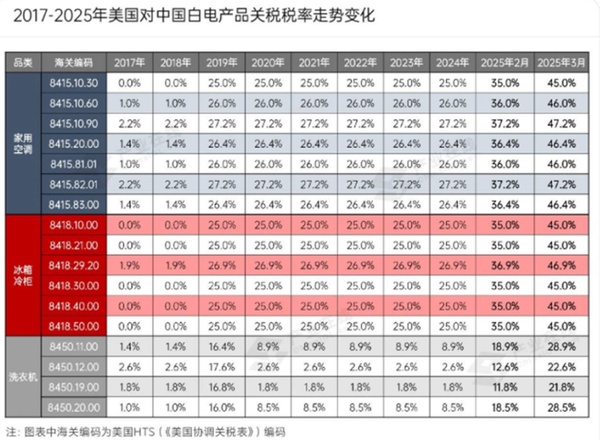Air conditioner domestic sales surge by 11.4%, while washing machine exports see negative growth: The分化时刻 of the home appliance industry in 2025 It seems there was a part left untranslated, "分化时刻," which means a moment or period of differentiation or divergence. A more natural translation for the title would be: Air conditioner domestic sales surge by 11.4%, while washing machine exports see negative growth: The Divergence of the Home Appliance Industry in 2025
According to the latest data released by========, the total production of the three major white appliances (air conditioners, refrigerators, and washing machines) reached 40.5 million units in March 2025, up 7.6% from the same period in 2024. This growth is mainly due to the recovery of the domestic market and the complex situation of the export market. However, the Trump administration's announcement of an additional 10% tariff on Chinese home appliances, combined with existing tariffs, has brought new challenges to the industry.
Domestic Sales Performance of Home Appliances in March 2025
In March 2025, domestic sales of home air conditioners were scheduled to reach 13.76 million units, a 11.4% increase compared to the same period in 2024. This growth can mainly be attributed to the promotion of national subsidy policies and the recovery of consumer demand. As a necessity during summer, the growth trend in domestic sales of air conditioners is particularly prominent under the influence of seasonal factors and policy stimulation.
Refrigerators: In March, domestic production and sales of refrigerators reached 4.36 million units, a year-on-year increase of 2.7%. Although the growth rate is limited, the refrigerator market still benefits from the dual drivers of national subsidy policies and consumption upgrades. Some enterprises have further stimulated market demand through promotions and the launch of new products.
Washing Machine: In March, the domestic production of washing machines reached 3.3 million units, a year-on-year decrease of 1.7%. The decline in the washing machine market is mainly due to the "trade-in" policy, which partially exhausted demand in advance, leading to weak market growth in the second half of the year. However, driven by policies, the washing machine market is still expected to maintain steady growth.
Performance of the Home Appliance Export Market in March 2025
Air Conditioners: In March, the export production of air conditioners reached 11 million units, a year-on-year increase of 9.2%. Despite the significant growth, this increase is mainly concentrated in emerging markets, such as Southeast Asia and Latin America. The US market may face pressure in future growth due to tariff adjustments and the advance of order demand.
Refrigerators: In March, refrigerator exports reached 4.43 million units, a year-on-year increase of 8.9%. The growth in refrigerator exports is mainly attributed to the replenishment demand in the European market and the economic recovery in the Latin American market. However, the pressure on exports has gradually become evident after the U.S. imposed additional tariffs.
In March, the export production of washing machines reached 3.65 million units, a year-on-year decrease of 1.0%. The decline in washing machine exports is mainly due to the impact of U.S. tariffs, especially with large washing machines facing anti-dumping duties of 49.72%, leading to a significant reduction in export orders.
III. Impact of U.S. Tariffs on the Home Appliance Industry
The Trump administration announced that, starting from March 4, 2025, a 10% additional tariff will be imposed on white goods exported from China to the United States. Combined with the existing tariffs, the comprehensive tax rate for air conditioners, refrigerators, and other products will reach 45%-47.2%. This policy has directly impacted the exports of Chinese home appliance companies to the U.S.

The air conditioning industry has been hit the hardest: As the most affected category, the comprehensive tax rate for air conditioners exceeds 45%, putting enormous pressure on corporate export profits. Data shows that China's air conditioner exports to the US decreased by more than 30% in 2024 compared to the previous year, with market share falling from 24% in 2018 to less than 10%.
Refrigerators and washing machines are facing dual pressures: the tariff rates for refrigerators and freezers range from 45% to 46.9%, while the rates for washing machines range from 21.8% to 28.9%. However, large washing machine products are subject to an anti-dumping duty of 49.72%. These tariff adjustments will further squeeze companies' profit margins.
Industry response strategies: In response to U.S. tax increases, Chinese home appliance companies have adopted multiple measures, including:
Capacity transfer: Chinese enterprises are accelerating the transfer of production capacity to Southeast Asian countries, especially Thailand and Indonesia. These countries attract a large number of home appliance companies to invest due to their low labor costs and favorable tax policies.
Global market layout: Enterprises are actively exploring emerging markets such as Latin America, Southeast Asia, and Africa. The economic growth and rising living standards in these regions are increasing the demand for home appliance products.
Technological Innovation and Upgrading: Enterprises enhance the added value of their products through technological innovation and product upgrading to compete in the international market.
Author: Zhao Hongyan, a plastic market analysis expert at Dedicated View

【Copyright and Disclaimer】This article is the property of PlastMatch. For business cooperation, media interviews, article reprints, or suggestions, please call the PlastMatch customer service hotline at +86-18030158354 or via email at service@zhuansushijie.com. The information and data provided by PlastMatch are for reference only and do not constitute direct advice for client decision-making. Any decisions made by clients based on such information and data, and all resulting direct or indirect losses and legal consequences, shall be borne by the clients themselves and are unrelated to PlastMatch. Unauthorized reprinting is strictly prohibited.
Most Popular
-

List Released! Mexico Announces 50% Tariff On 1,371 China Product Categories
-

Nissan Cuts Production of New Leaf EV in Half Due to Battery Shortage
-

New Breakthrough in Domestic Adiponitrile! Observing the Rise of China's Nylon Industry Chain from Tianchen Qixiang's Production
-

Dow, Wanhua, Huntsman Intensively Raise Prices! Who Controls the Global MDI Prices?
-

Mexico officially imposes tariffs on 1,400 chinese products, with rates up to 50%






